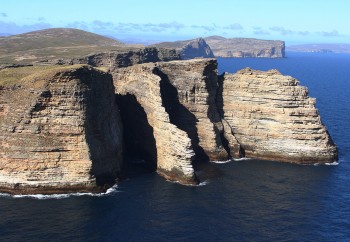
An aerial view of Landsend Bluff on the west coast of New Island. Sheer cliffs rising over 200 metres dominate this side of the island and form breeding sites for ACAP-listed and Endangered Black-browed Albatrosses Thalassarche melanophris. New Island is the most westerly island in the Falkland Islands (Islas Malvinas)*. The island has a coastline of roughly 84 km and is approximately 13 km in length. New Island was first established as a private nature reserve in 1972. It is also an Important Bird Area and a site for research on its seabirds. In 2006 the island came under the single management of the New Island Conservation Trust, a non-profit, charitable conservation body, with small-scale tourism allowed.
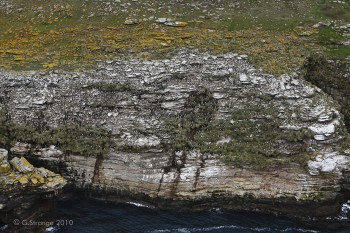
Aerial view of one of the Black-browed Albatross colonies on New Island. Aerial photographic survey methodology was adopted due to the formidable terrain making more conventional ground surveys virtually impossible. In the last aerial photographic survey in 2010 a total of 14 487 adult pairs occupying nests was counted on New Island. The total count for the Falkland Islands (Islas Malvinas)* was then 475 465 pairs.
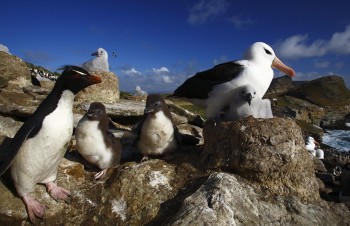
The majority of the 12 Black-browed Albatross colonies in the Falkland Islands (Islas Malvinas)* are mixed with Southern Rockhopper Penguins Eudyptes chrysocome and King or Imperial Cormorants Phalacrocorax atriceps albiventer. The penguins often breed in very close proximity to the albatross nests. A few (<50 pairs) of ACAP-listed White-chinned Petrels Procellaria aequinoctialis breed on the island on Rookery Hill. Very large numbers of Thin-billed Prions Pachyptila belcheri also breed on New Island.
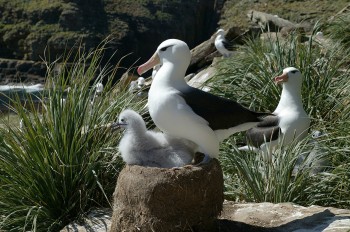
An adult Black-browed Albatross with its chick in one of the New Island colonies. On this particular site the albatrosses nest amongst Tussac Grass Parodiochloa flabellata without any other colony-nesting species. The large nest shown here suggests the site has been used for a considerable number of years.
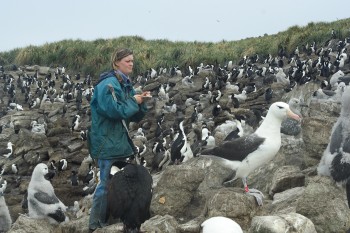
Photographs by Ian Strange and Georgina Strange
A researcher works in a mixed colony of Black-browed Albatrosses, Southern Rockhopper Penguins and King Cormorants on New Island. Research on albatrosses on New Island has been carried out over a period of 35 years. Annual counts of breeding pairs on one of the main colonies, which commenced in 1975, have shown an increase of over 136%, or 4.1% a year to the present time.
Selected References:
Catry, P., Forcada, J. & Almeida, A. 2011. Demographic parameters of Black-browed Albatrosses Thalassarche melanophris from the Falkland Islands. Polar Biology 34: 1221-1229.
Matias, R & Catry, P. 2008. The diet of feral cats at New Island, Falkland Islands, and impact on breeding seabirds. Polar Biology 31: 609-616.
Quillfeldt, P., Schenk, I., McGill, R.A.R., Strange, I.J., Masello, J.F., Gladbach, A., Roesch, V. & Furness, R.W. 2008. Introduced mammals coexist with seabirds at New Island, Falkland Islands: abundance, habitat preferences, and stable isotope analysis of diet. Polar Biology 31:333-349.
Reid, T., Lecoq, M, & Catry, P. 2007. The White-chinned Petrel Procellaria aequinoctialis population of the Falkland Islands. Marine Ornithology 35: 57-60.
Strange, I.J. 2007. New Island, Falkland Islands: a South Atlantic Wildlife Sanctuary for Conservation Management. Stanley: Design in Nature. 152 pp.
Strange, I.J. 2008. Aerial Surveys of Black-browed Albatross Thalassarche melanophris: the Methodology Employed and Comparisons with Surveys Carried out in 1986-2005-2006 and 2007. New Island: Design in Nature & Falkland Islands Wildlife. 59 pp.
Strange, I.J. & Strange, G. 2011. Black-browed Albatross Thalassarche melanophris. Aerial Photographic Survey Methodology: Advantages over Ground Surveying in the Falkland Islands. Results and Comparisons with Surveys in 2005 and 2010. Stanley: Design in Nature. 30 pp.
Wolfaardt, A.[C.] 2012. An Assessment of the Population Trends and Conservation Status of Black-browed Albatrosses in the Falkland Islands. 23 pp.
Wolfaardt, A.C., Rendell, N. & Brickle, P. 2010. Falkland Islands Implementation Plan for the Agreement on the Conservation of Albatrosses and Petrels (ACAP): Review of Current Work and a Prioritised Work Programme for the Future. Stanley: Falkland Islands Government. 57 pp.
Ian Strange, New Island Conservation Trust, New Island, 05 April 2013
*A dispute exists between the Governments of Argentina and the United Kingdom of Great Britain and Northern Ireland concerning sovereignty over the Falkland Islands (Islas Malvinas), South Georgia and the South Sandwich Islands (Islas Georgias del Sur y Islas Sandwich del Sur) and the surrounding maritime areas.

 English
English  Français
Français  Español
Español